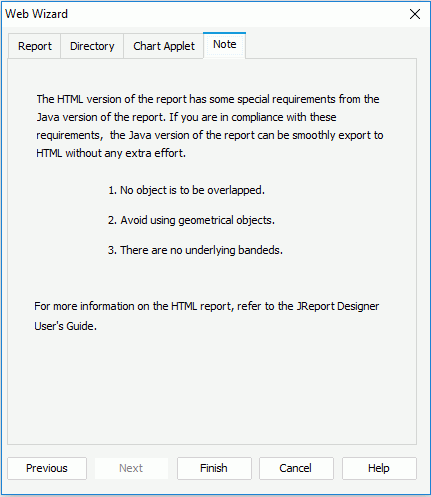 Previous Page Next Page
Previous Page Next Page
This wizard appears when you click File > Export > To HTML. It helps you to export a report to HTML format, and consists of the following tabs:
Previous
Retains changes and returns to the previous tab.
Next
Retains changes and goes to the next tab.
Finish
Completes the exporting.
Cancel
Does not retain any changes and closes the wizard.
Help
Displays the help document about this feature.
Specifies the options applied to the report.

Export to
Specifies whether to export the report result to a single HTML file or multiple HTML files.
Select Report Tabs
When exporting a page report, you can specify the report tabs in the page report you want to export. The selected report tabs will be exported in the list order. If the report has only one report tab, it is selected by default.
Web Page Name
Specifies the name of the exported file. When exporting a page report, you need to specify the name for each report tab.
If you do not type the name, JReport will use the report name as the default HTML file name. JReport automatically attaches the extension *.html, so you do not have to type the extension yourself.

Moves the specified report tab one step up.

Moves the specified report tab one step down.
Web Browser
Specifies the web browser for which the HTML result adapts.
Text Overflow
Specifies whether the text overflow is visible or hidden.
No Margin
Specifies whether to remove the margins originally set when the report was designed.
Drilldown
Specifies whether to include the drilldown file in the exported HTML file.
TOC
Specifies whether to enable the TOC (Table of Contents) in the exported HTML file.
No Hyperlink
If checked, there will be no hyperlinks for navigating previous and next pages on the navigation bar of the exported HTML file. Enabled only when Single File is selected.
No Page Number
If checked, there will be no page number information showing the current page number and total page number on the navigation bar of the exported HTML file. Enabled only when Single File is selected.
Embedded CSS
Specifies whether to embed the cascading style sheet (CSS) in the exported HTML files; otherwise, the .css file will be generated individually. Enabled only when Multiple Files is selected.
Section 508 Compliant Output
If checked, the accessibility attributes defined for the report elements via the Report Inspector will be exported to the HTML result which is Section 508 compliant. See Accessibility for more information.
When Section 508 Compliant Output is checked, the Use HTML Data Table and Relative Font Size options will be checked and disabled. The output will be Section 508 compliant including HTML data table, accessible attributes, and relative font feature.
Use HTML Data Table
Specifies whether the table and crosstab components will be output as table objects in the HTML result.
Absolute Font Size
Specifies whether to generate the report result using an absolute font size, which means the font size is fixed and cannot be adjusted according to the font size settings in the web browser.
Relative Font Size
Specifies whether to generate the report result using a relative font size, which means the font size can be adjusted according to the font size settings in the web browser.
Run Linked Report
If the report is linked with other reports, you can check whether or not to generate the linked reports (not including the detail reports) in the exported HTML file. If you are only interested in the primary report, leave this option unchecked. Generating linked reports at the same time, especially when the linked reports contain a large amount of data, will cause performance issue.
Specifies the location in which to place the exported HTML files.

Directory
Specifies the destination directory where you want to place the exported HTML file.
If you have used dynamic charts in your report, they can still be available in the exported HTML file. If Embed chart applet has been checked, dynamic 3-D charts will remain interactive and be available in the outputted HTML file. If Save in image has been checked, the charts will be converted to images. Also, you can specify the format of the images by choosing from the drop-down list (GIF or JPEG. The default format is JPEG).

Applet Chart
Uses a Java applet to display the charts in an HTML result file.
If checked, for Google Chrome, the report in the file can be viewed only when NPAPI is enabled for the web browser.
Image Chart
If checked, charts will be converted to images and you can specify the image type from the drop-down list. However, the transparency property of the charts takes effect only when PNG is selected as the image type.
This tab includes important information about HTML. We recommend that you read the contents in the Note tab before you convert your report to HTML format.
